One of the biggest visual changes to warships over the last 40 years, rivaled only by the widespread use of phased arrays, is the adoption of the Vertical Launch System or VLS as the primary way of carrying and firing missiles. The basic idea is simple. Instead of storing missiles in a magazine and bringing them out to fire, store the missiles in vertical tubes, each of which is also set up as a launch cell. This brings numerous advantages. First and foremost, it is far simpler than previous missile launchers, with a dramatically reduced maintenance burden, as almost all of the important bits are kept protected from weather until the missile is fired. All missiles are kept in instant readiness to fire, allowing the ship to respond to changing threats quickly and with a significant fraction of its available weapons. Perhaps more important than all of these is the fact that a modern VLS can carry multiple types of missiles, giving a vital multi-role capability and allowing a ship to change missions with a quick port visit.
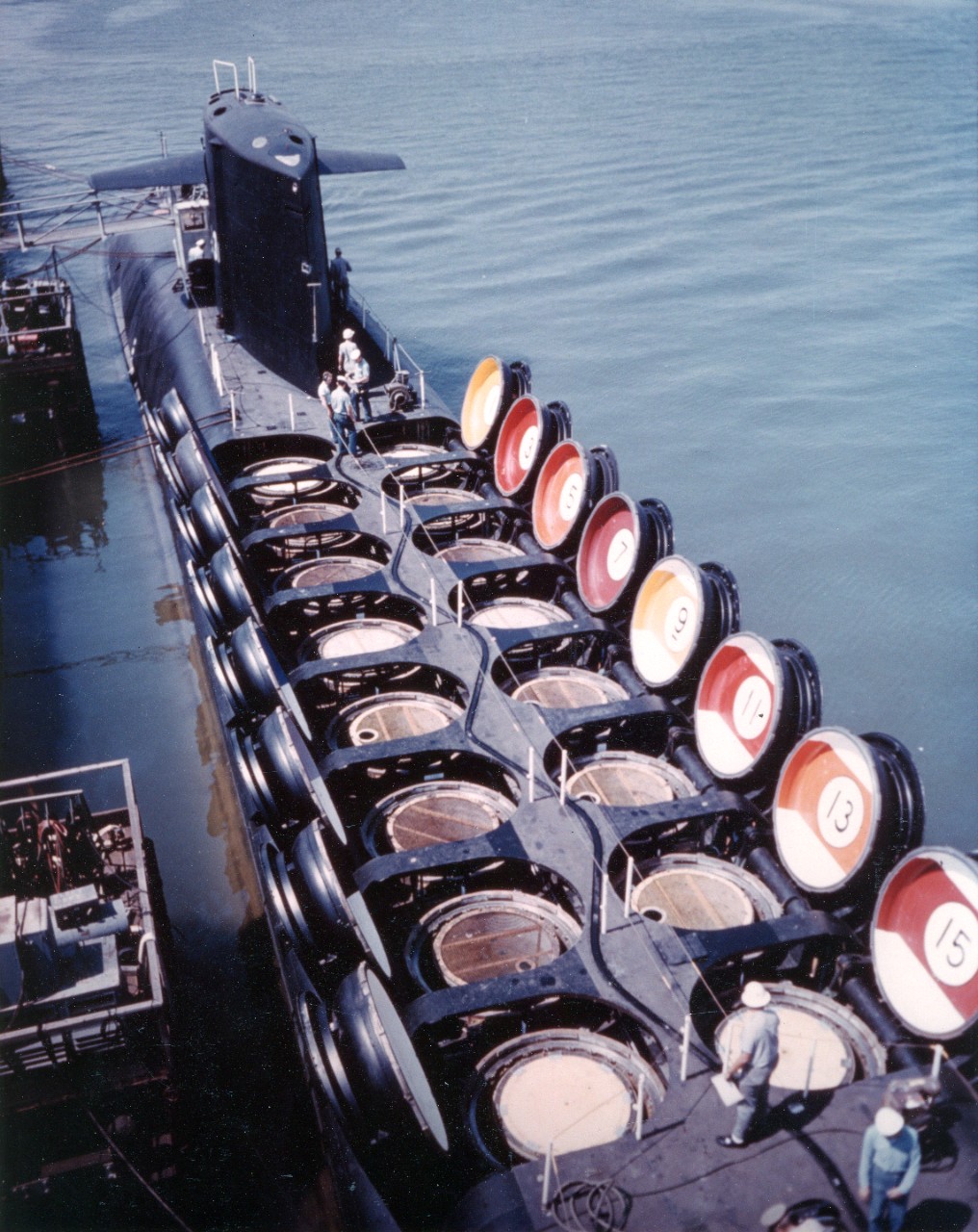
An early VLS in use
The idea of a fixed launcher obviously goes back quite a ways. The first hints of the concept can be seen in the use of gyro angling to allow off-bore torpedo shots, most prominently the fixed tubes on the Nelsons. All but the earliest anti-ship missiles were launched from fixed tubes installed at an angle, with vertical launch arriving shortly thereafter for ballistic missiles. This allowed designers to avoid moving large, heavy missiles while at sea, although it required that the missile have substantial guidance capability already onboard. This wasn't a problem for ASMs or SLBMs, but it would have been a serious challenge to integrate something of this nature on a SAM in the 50s and 60s. These required guidance from the launching ship, and a trainable launcher allowed the missile to guide right away. Despite these problems, the British looked at something VLS-like for the missile that became Sea Slug, although they ultimately went with a trainable launcher when they settled on beam-riding guidance
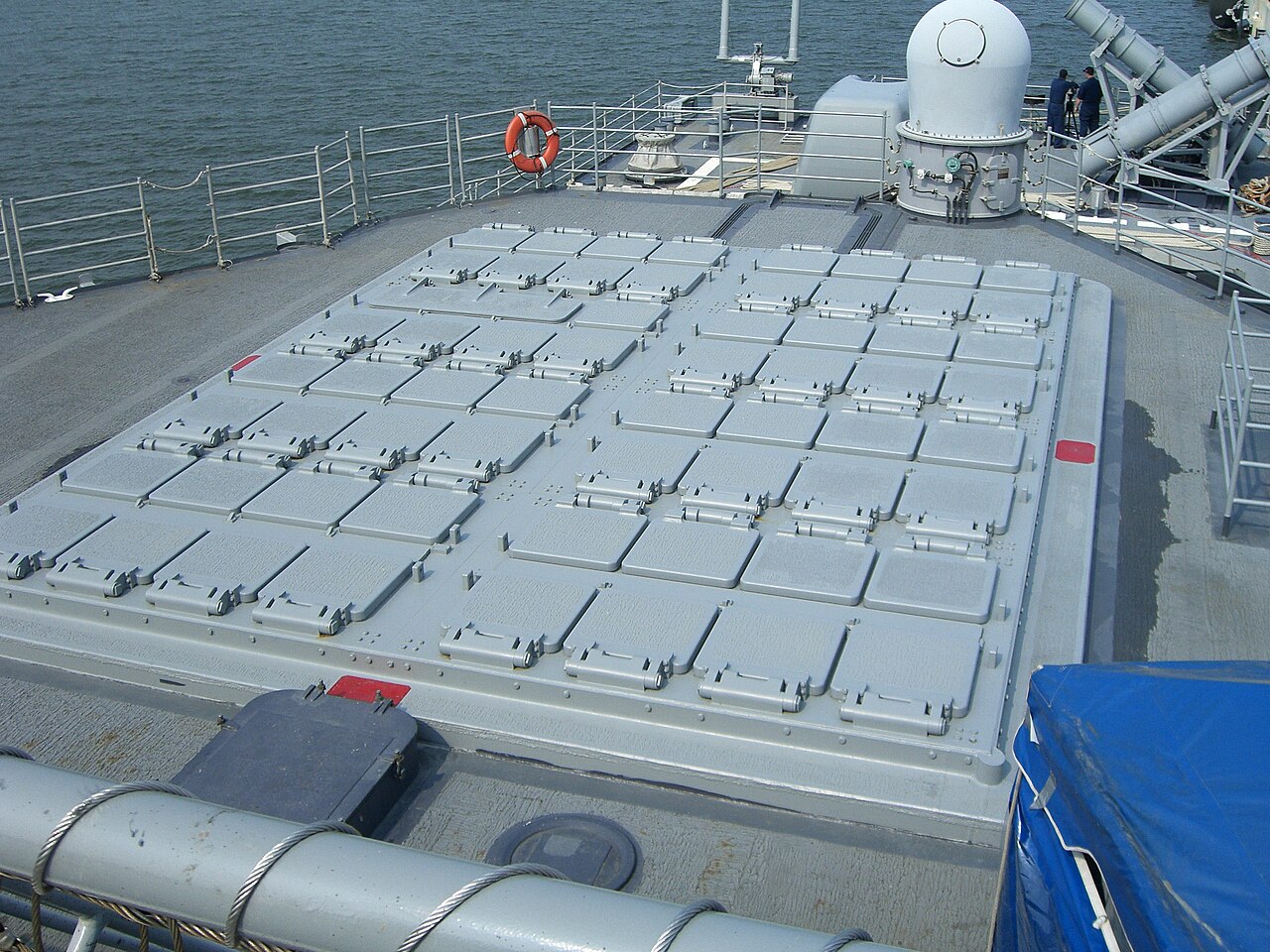
The VLS on Normandy
By the 70s, electronics had reached the point where it was relatively cheap to incorporate an autopilot into a SAM, a capability initially used to help economize on shipboard illuminators. The ability to launch the missile blind meant it didn't need to be fired in the direction of the target, allowing fixed launchers to take over for SAMs. Because an incoming airplane or missile might arrive from any direction, straight up was the obvious direction to launch, and the US and Russia both introduced systems that worked this way in the mid-80s, but with very different approaches.
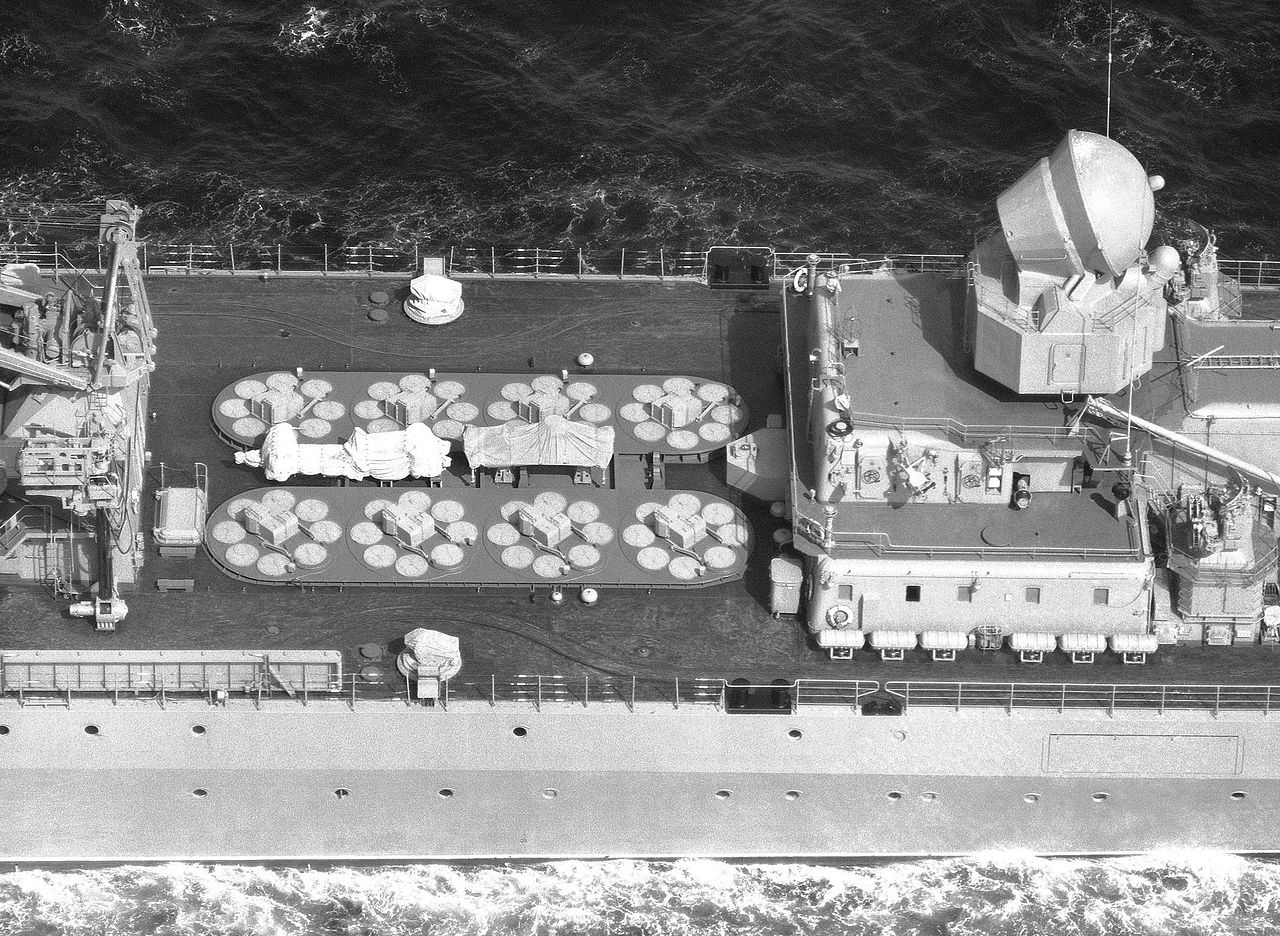
SA-N-6 launchers on Marshal Ustinov
The Soviet system, used for the S-300F (SA-N-6) missile installed on the Kara and Kirov classes, was in many ways the more conventional of the two. It housed the missiles in an 8 or 12-round rotary canister under the deck, with the missiles rotating into a single launch position to fire. Upon launch, the missile was propelled up by a blast of compressed air, igniting its motor once it was 20 m or so up and well clear of the launcher. This was good for safety, as it meant that there was nothing high-energy inside the ship, and any failures would take place at a safe distance from anything important.1
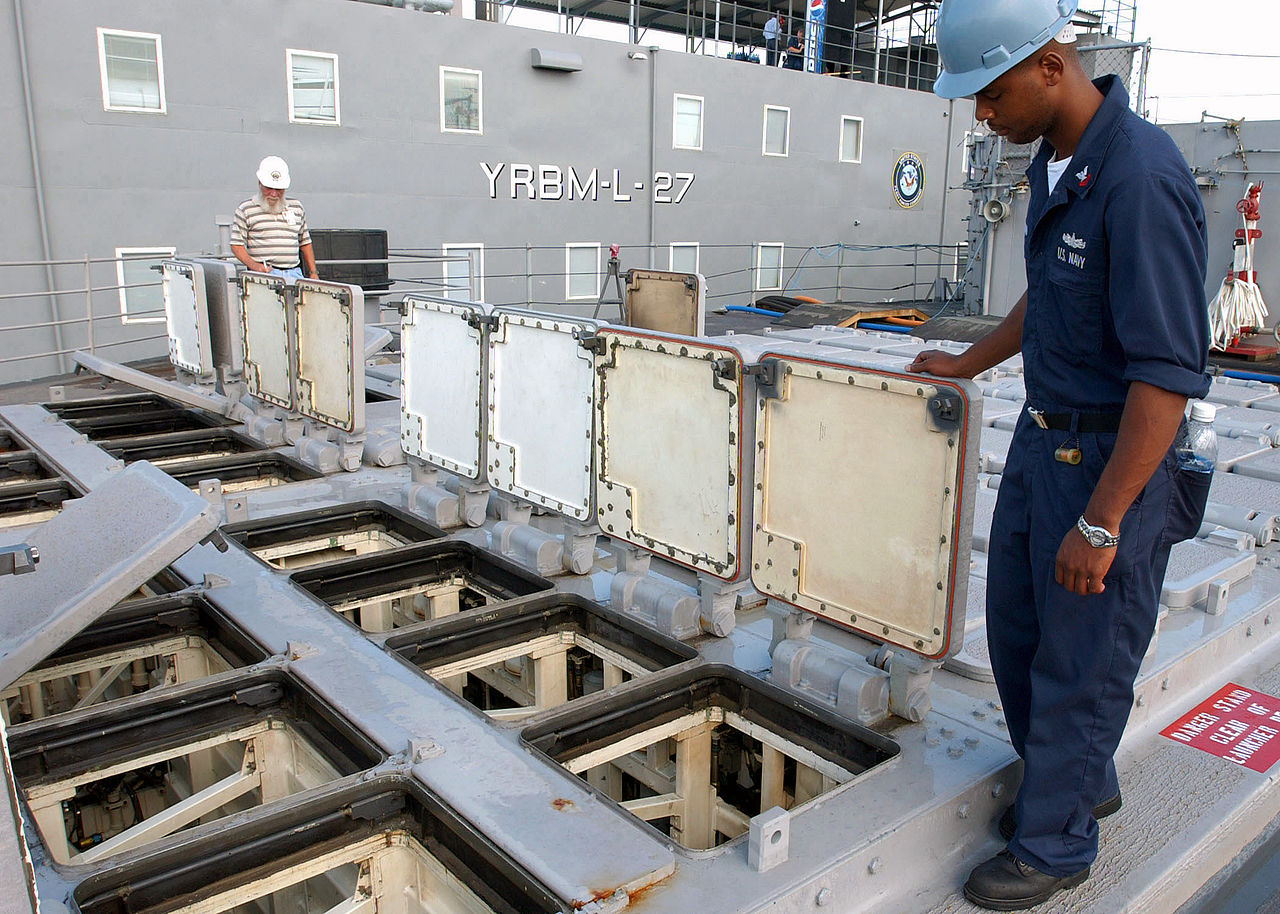
Open VLS cells on Hue City
The Americans took a very different tack, as might be expected given the differences in technology and operational philosophy between them and the Soviets. Instead of a simple single-purpose system, well proofed against failure, they chose a system that was in some ways more complex, but also far more flexible, ultimately to play a major part in changes that swept over naval warfare in the last decade of the 20th century. Each missile would be placed in a sealed canister which would keep it safe during transit, then be loaded into the VLS, where it would also serve as the launcher. This meant that any type of missile that fit in the canister could be used. To simplify things, the Americans used a hot-launch method, igniting the missile's motor in the tube and letting it propel itself out. This would require careful thermal management, particularly if the missile got stuck, and if something went wrong, the results might be catastrophic. But the flexibility and instant availability of this solution won the day, and the system entered service as the Mk 41, currently fitted to every major American combatant, as well as those of many of our allies.
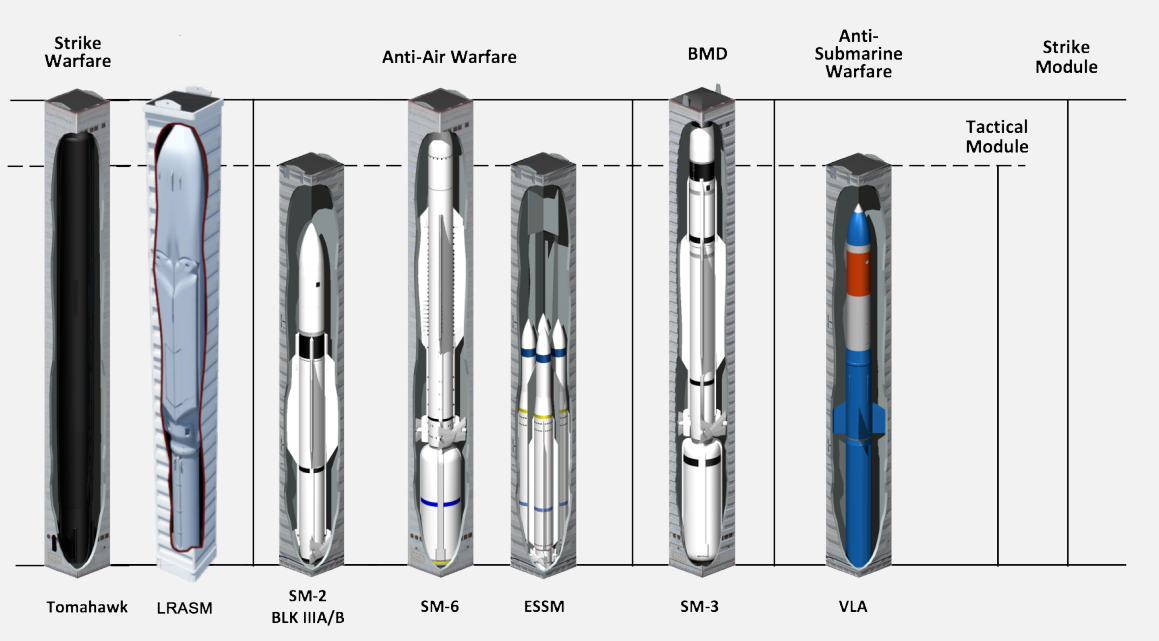
Different VLS Options. Courtesy of Lockheed Martin.
Instead of tightly wrapping a cell around Standard, the designers used the new Tomahawk as their template, producing a canister that was 25x25", with length varying by the type of missile, which in turn meant that Mk 41 systems came in three lengths. The shortest, known as self-defense length, was designed to carry Sea Sparrow and later ESSM. Longer was "tactical", which added the capability for Standard MR2 and the planned vertical-launch replacement for ASROC. Tomahawk, the longest of the initial missiles, required "strike length", although tactical canisters could still be fired thanks to the use of a spacer . Obviously, the longer cells are heavier, but also bring extra capability. Strike length is near-universal in USN service,3 while other nations use a mix of strike and tactical lengths, depending on their interests. Self-defense length appears to be defunct, probably due to the development of the specialized Mk 48, although some reports suggest that they couldn't handle ESSM Block II.
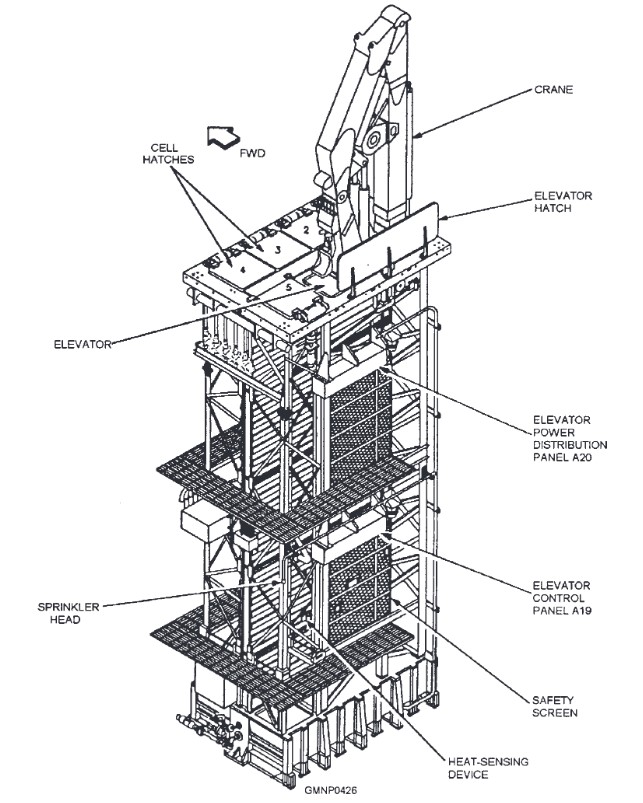
A diagram of the strikedown module
Cells would come in clusters of 8 (2 rows of 4 cells), allowing the size of a VLS installation to be tailored to the ship. Each cluster shares a common plenum for the exhaust, which is sent through the gap between the two rows of cells. There was also a version that replaced three cells with a strikedown crane, intended for replenishing missiles at sea. This was never a popular procedure, and the crane couldn't handle Tomahawk canisters, so with the increasing emphasis on the strike mission in the 1990s, the strikedown modules were replaced on the Flight IIA Burkes with 8-cell conventional modules, and the cranes were largely removed from ships that had them. In the event that a missile is fired but doesn't leave the cell, there are fittings for "water deluge", which should keep the temperature under control and avoid damaging neighboring missiles.
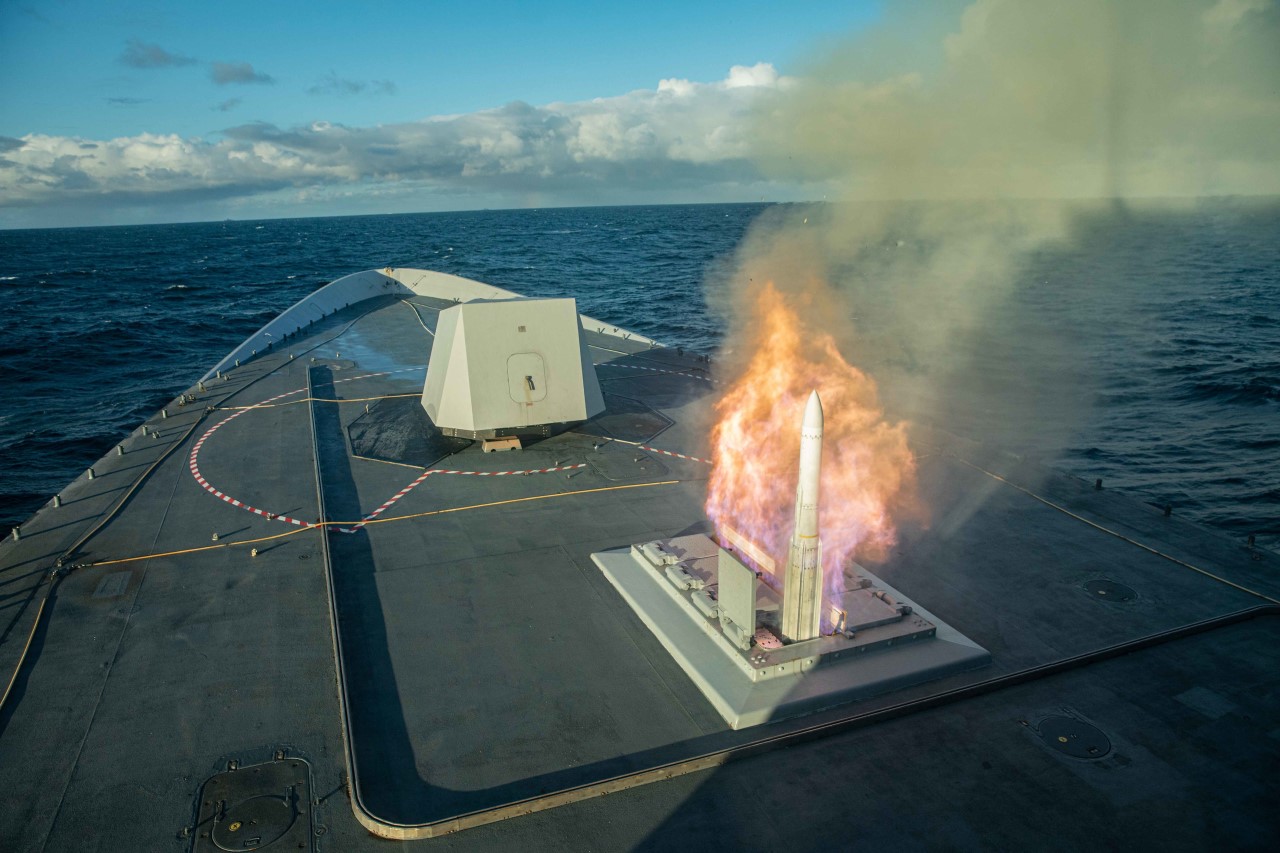
Norwegian frigate Fridtjof Nansen fires an ESSM
The Mk 41 first went to sea aboard Bunker Hill, the sixth unit of the Ticonderoga class cruisers,4 which had 122 cells in two sets fore and aft. A 61-cell VLS was soon refitted to the earlier Spruance class destroyers in place of their forward ASROC launchers, although they could only carry Tomahawk and VL-ASROC. The nascent Burkes had 29 forward and 61 aft, and export customers, including Australia, Canada, Denmark, Germany, the Netherlands, Japan, Norway, South Korea and Spain, have installed it on their warships, with Finland and Britain about to join them.
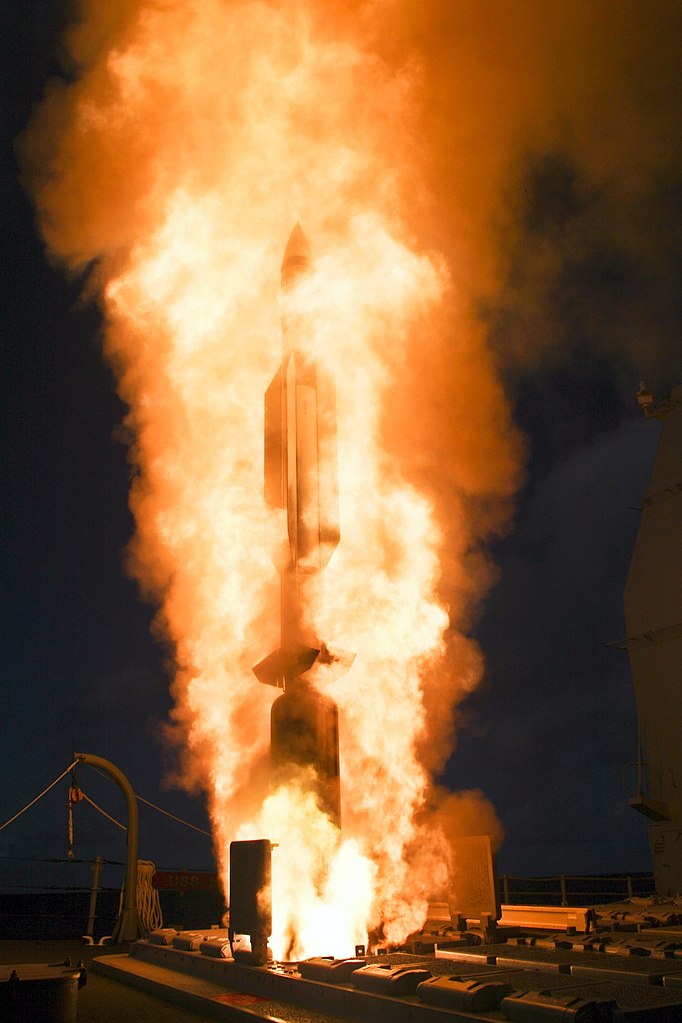
An SM-2ER is launched from Lake Erie
Nor has weapon development stood still since the Mk 41's introduction. Even the Strike-length is far too short for the old RIM-67, but the USN soon realized that they could take advantage of the greater diameter of the Mk 41 to fit a squat booster for a weapon that could be packaged into a strike-length canister. Some of the motive was down to the imminent retirement of the existing RIM-67 ships, but a lot of it was the need for faster weapons to shoot down ballistic missiles, a threat clearly shown by the SCUD during Desert Storm. To allow the maximum possible diameter, the booster was finless and steered by vectoring the thrust it produced. Several different versions of the Standard were produced using this booster design, most notably the SM-3 and SM-6. Thrust vectoring was also used for the ESSM, where it gave control far earlier than fins would have, a vital feature in a point-defense missile. ESSM was fitted in a quad-pack, allowing far greater loads than with previous missiles. There has been discussion of using multiple packs of other types of missiles to expand VLS capacity further, most a dual-pack of SM-2MR, but nothing has ever come of such plans. More recently, the growing threat of the PLAN has raised interest in a proper anti-ship missile in the VLS, with both LRASM and JSM discussed, although neither seems to have actually been procured in this form.
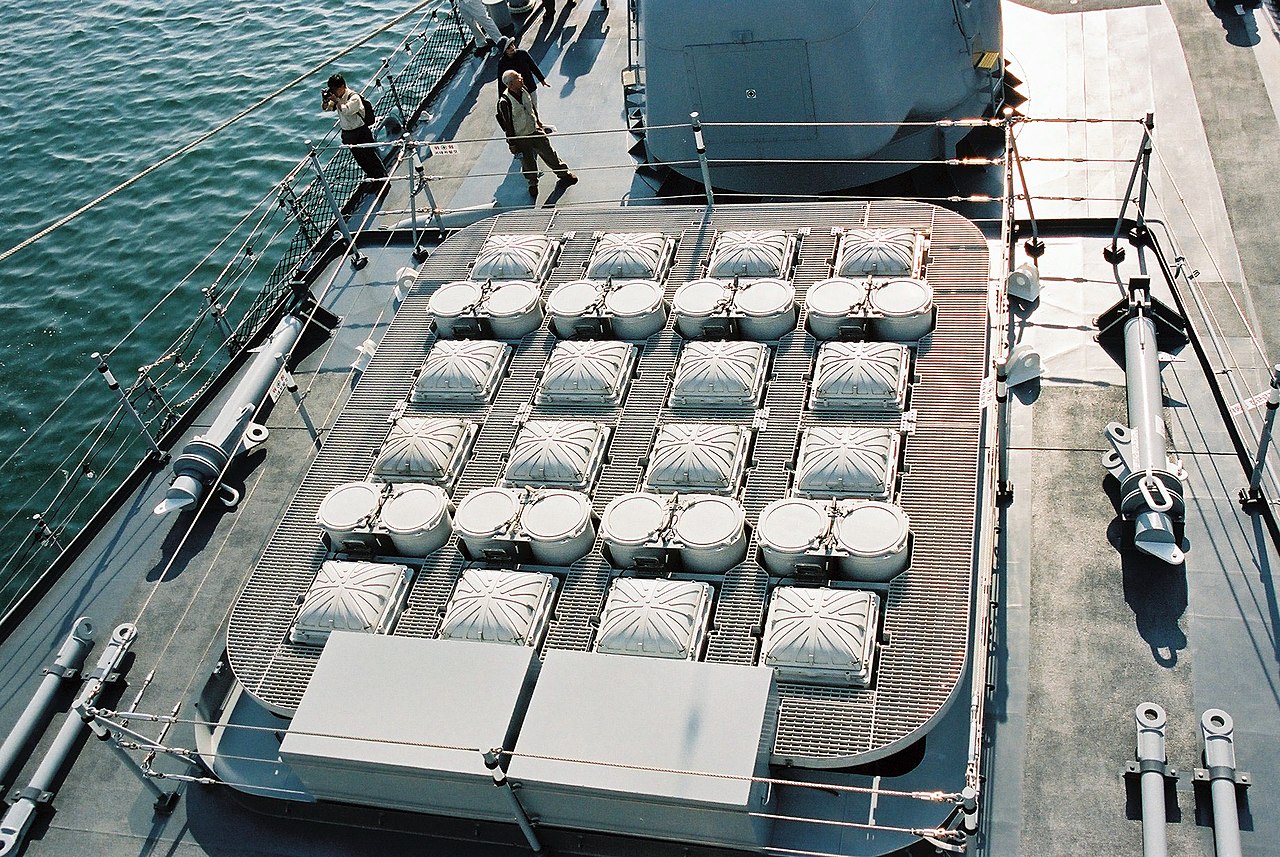
Mk 48 aboard South Korean destroyer Gwanggaeto the Great
Nor has Mk 41 had the VLS field to itself. First to join it was the Mk 48, designed for self-defense missiles, either a single Sea Sparrow or a two-pack of ESSM in each cell. The Mk 48 comes in several different configurations, with 2, 65 or 16 cells. Unlike the Mk 41, it is usually mounted above the deck, and while the USN hasn't used it, the Belgian, Japanese, Danish, Canadian, Greek and South Korean navies have. It has since been superseded by the Mk 56, which is generally similar, but uses composites to reduce weight about 20%. More radical is the Mk 57, designed for the Zumwalt class destroyers. Unlike the Mk 41, it is designed to be installed around the edge of the ship, and it is 28"x28" to accommodate larger missiles, although none have been procured so far. The gas management system has been redesigned as well, able to deal with 45% higher exhaust flows than the Mk 41 and deal with a restrained missile without the use of the water deluge, eliminating a major driver of maintenance on the older system. An even more recent development is the "Adaptive Deck Launcher", which is essentially a deck-mounted rack that can carry 4 Mk 41 canisters, giving the Navy a way to add VLS-like versatility to ships that are already in service.
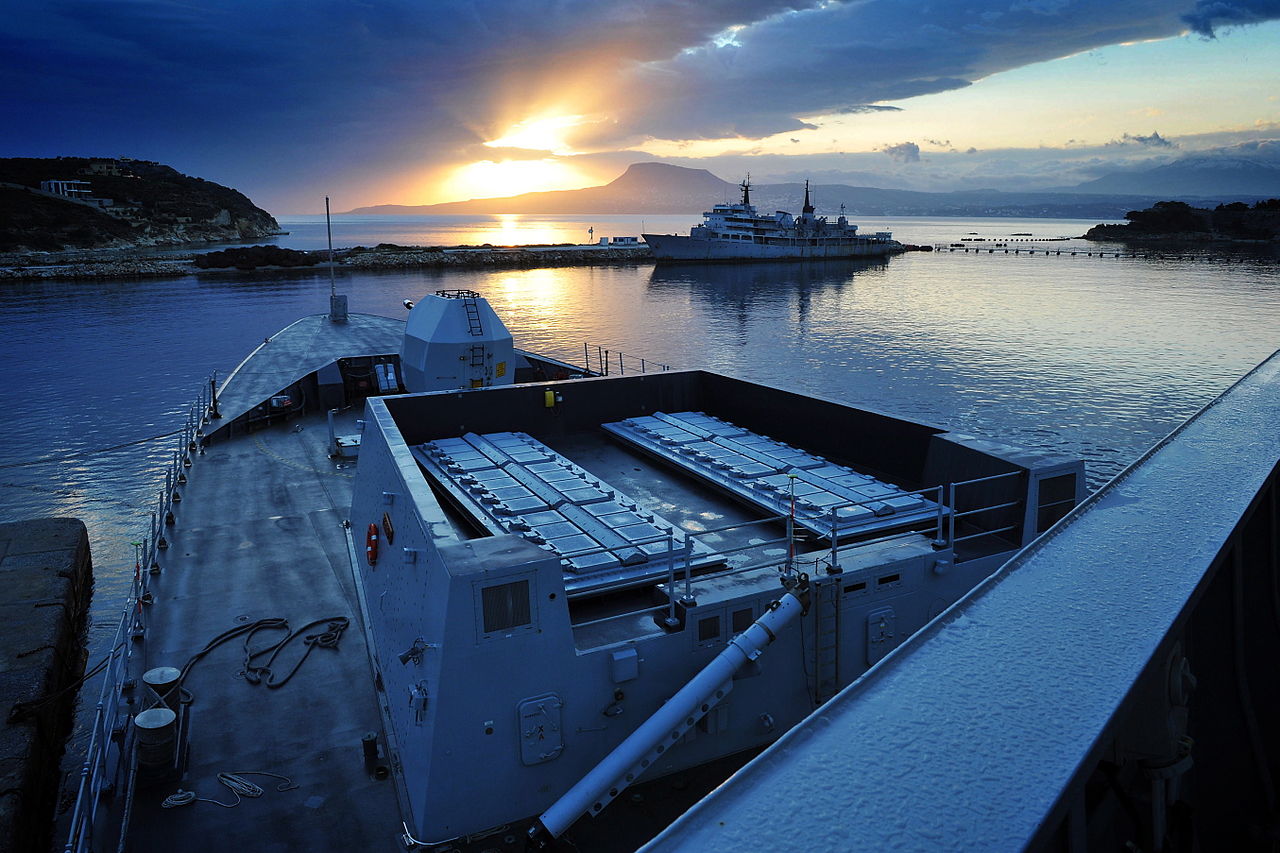
Sylver VLS aboard HMS Daring
While the US has been the leading exponent of vertical launch, other nations have seen the benefits and built similar systems of their own. France developed the Sylver, which is primarily equipped with the Aster missile, although the French also have theirs fitted with the MdCN cruise missile. The Koreans also have the imaginatively-named Korean Vertical Launching System, which is used on several ships for a mix of anti-ship, land-attack and point-defense missiles, as well as the Korean equivalent to ASROC.
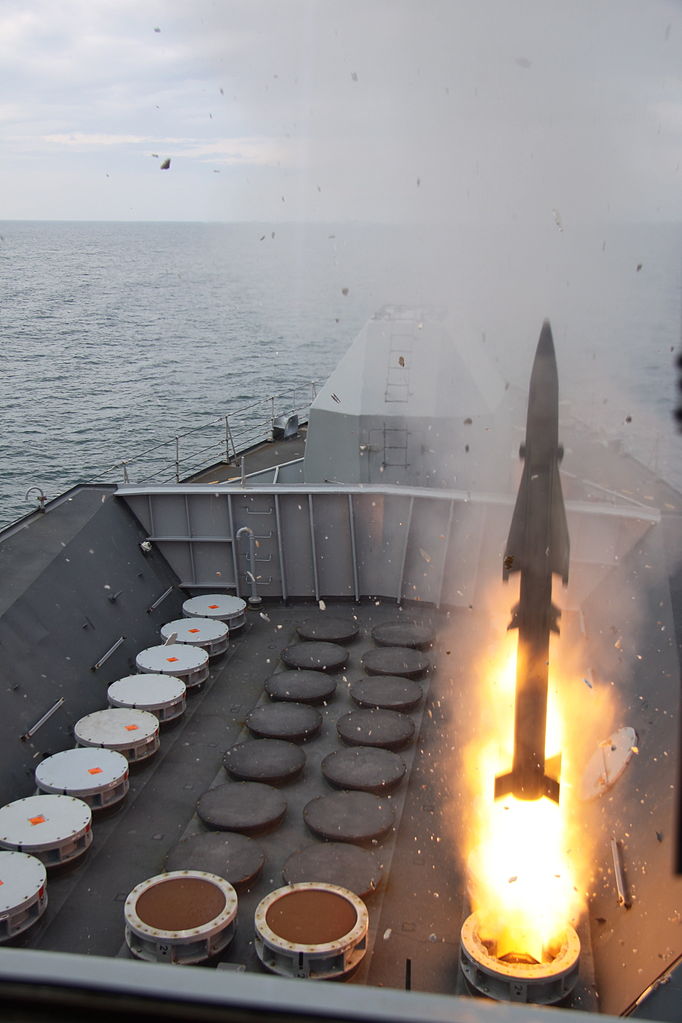
A VLS Sea Wolf is fired from HMS Richmond
There has also been fairly extensive use of single-purpose VLS, tailored to the specific missile. Besides the SA-N-6 discussed above, the Russians also use such systems for most of their SAMs, and a number of their ships also have limited-purpose VLS for a mix of anti-ship and land-attack missiles. The British seem to prefer dedicated vertical launchers for point defense missiles, both the 80s Sea Wolf and the modern Sea Ceptor. Submarines tend to be equipped with this type of VLS, which gives capacity for an extra dozen or so cruise missiles, although recent years have seen a trend towards the use of universal launchers which can be adapted to weapons other than Tomahawk or the national equivalent.
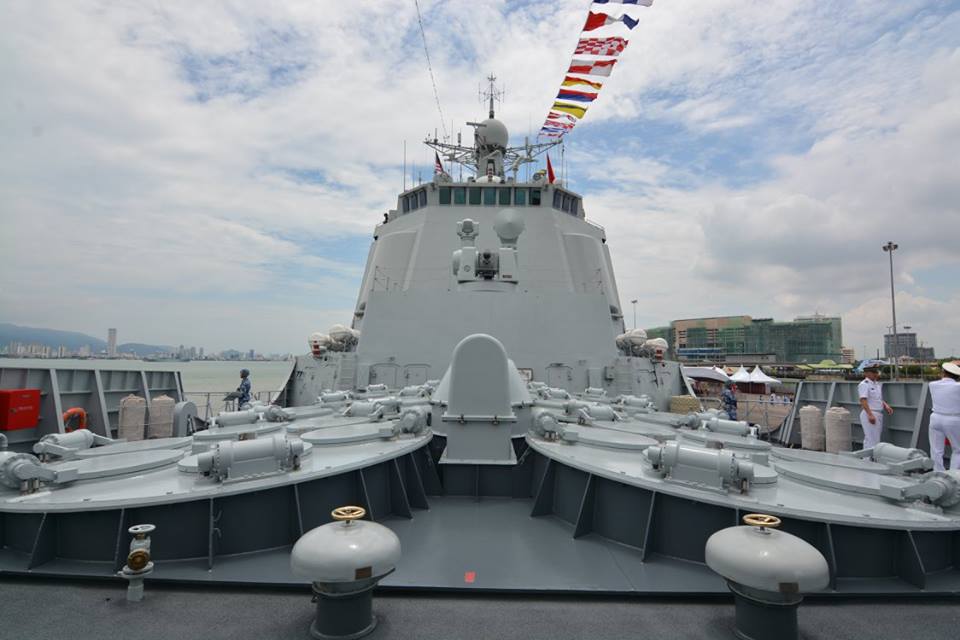
Cold-launch revolver VLS aboard a Type 52C destroyer
Of course, no discussion of these systems would be complete without a mention of China, which has developed several systems of its own, most notably the current GJB 5860. This is a so-called "concentric canister launcher", which can support both hot and cold launches from the same cell. The SAM it carries is cold-launched, while anti-ship and land-attack missiles are hot-launched, presumably because the SAMs were originally developed on the Russian model, while the cruise missiles were not. This system has been fitted to the Type 52D and Type 55 destroyers, giving them the same versatility enjoyed by the USN's surface combatants.
The Vertical Launch System is one of the keys to warship design over the last 40 years, but despite that, the history of the system itself is relatively obscure. I've been wanting to write this post for years, but was stymied by a lack of sourcing, particularly on the early years of development. The best I've found are two articles from Proceedings about the work done before the Mk 41 was finalized, but they finally gave me the key to unlocking this. For more information on US systems in particular, there's this Gunner's Mate training course and a recent paper on the future of VLS.
1 Most cold-launch systems are at a slight angle, so that any failures fly clear of the ship instead of landing on the deck. It's not entirely clear that this is the case for the SA-N-6, because there is not that much information on the system in my sources. ⇑
2 The existing Standard ERs would have been far too long for any plausible VLS. ⇑
3 As best I can tell, Constellation herself is getting tactical-length, but follow-on ships will have strike-length VLS. ⇑
4 The previous five had received the Mk 26 twin-arm launcher, reportedly because of concerns that the VLS would not look sufficiently intimidating. ⇑
5 The 6-cell Mk 48 is used in the Danish StanFlex modular system. ⇑

Comments
I'm curious as to what the advantage of the Mk 48 is over the self-defense length Mk 41. Looking at some advertising literature from LockMart and BAE Systems, an eight-cell Mk 41 capable of holding 32 quad-packed ESSM has a deck footprint of 2.1 x 3.2 m, whereas a sixteen-cell Mk 48 with the same 32-ESSM loadout (now double-packed) has a footprint of 4.8 x 4.2 m. The Mk 48 looks save about 400 kg of weight, out of 30+ metric tons fully loaded, and 0.6 m in height, but those seem like small potatoes compared to tripling the deck space. That picture of "Gwanggaeto the Great" certainly doesn't look like efficient packaging.
OK, something something Mk 41 not compatible with ESSM Block II, but it's hard to believe that's something that couldn't have been fixed with minor changes to the Mk 41 or the ESSM cannister, and even harder to believe that it would require such a massive increase in deck space.
Oh, it's just the self-defense length that isn't compatible with ESSM Block II. It works fine in the full lengths.
Thinking it over, I suspect that the answer may be a combination of weight and height (there may be extra structure outside the Mk 41 cell, and if it's high in the ship, every little bit helps) and lower maintenance if the Mk 48 doesn't need the water deluge system.
@John Schilling: One of the bigger things with the Mk48 is that a smaller VLS nest is available: you can have 2 or 6 canisters instead of 8. Additionally, some of the variants are designed for mounts other than inside a ship. The 2 cell versions included on deck and bulkhead mounting, so you don't necessarily need to have precious below deck centerline space for them.
As for the Mk41 SDLS and ESSM, apparently the ESSM Block II is heavier, and that may actually exceed the weight limit for the self defense length system to have 4 in there.
I wonder what the additional impact on weapon design is from having the missile fly through the exhaust during launch (as in the picture from the Lake Erie), or alternately if they looked at just having a pure 'canister launch' without the central exhaust duct.
Given the intensity of the heat it's likely non-zero, but it's also (hopefully) in the blast zone for a short enough time period that the total energy transfer isn't huge.
A criticism of VLS is that they can't be reloaded at sea, but were the previous generation magazine and launcher systems any better in practice?
@Hugh
Yes, they were. Unrep was a fairly major concern for the USN through the end of the Cold War, and I think the Okieboat site has some info on how they did it with Talos. With the demise of the Soviets and the rise of the Tomahawk mission, the desire to do so faded, and the cranes went away.
@Hugh Fisher: The VLS cranes were essentially swinging a pendulum around as you tried to get the loaded canister into the launcher cell. This is somewhat difficult at any sort of sea state.
The USS Oklahoma (and other Talos/Terrier ships) were able to take the missile onboard, then strap them onto rails for movement to the "strikedown" system to the magazines. They largely didn't swing around but were under positive control at all times. The Mk26 GMLS launcher also had a "strikedown" system on the deck that also allowed positive control of the Standard Missiles during reloading.